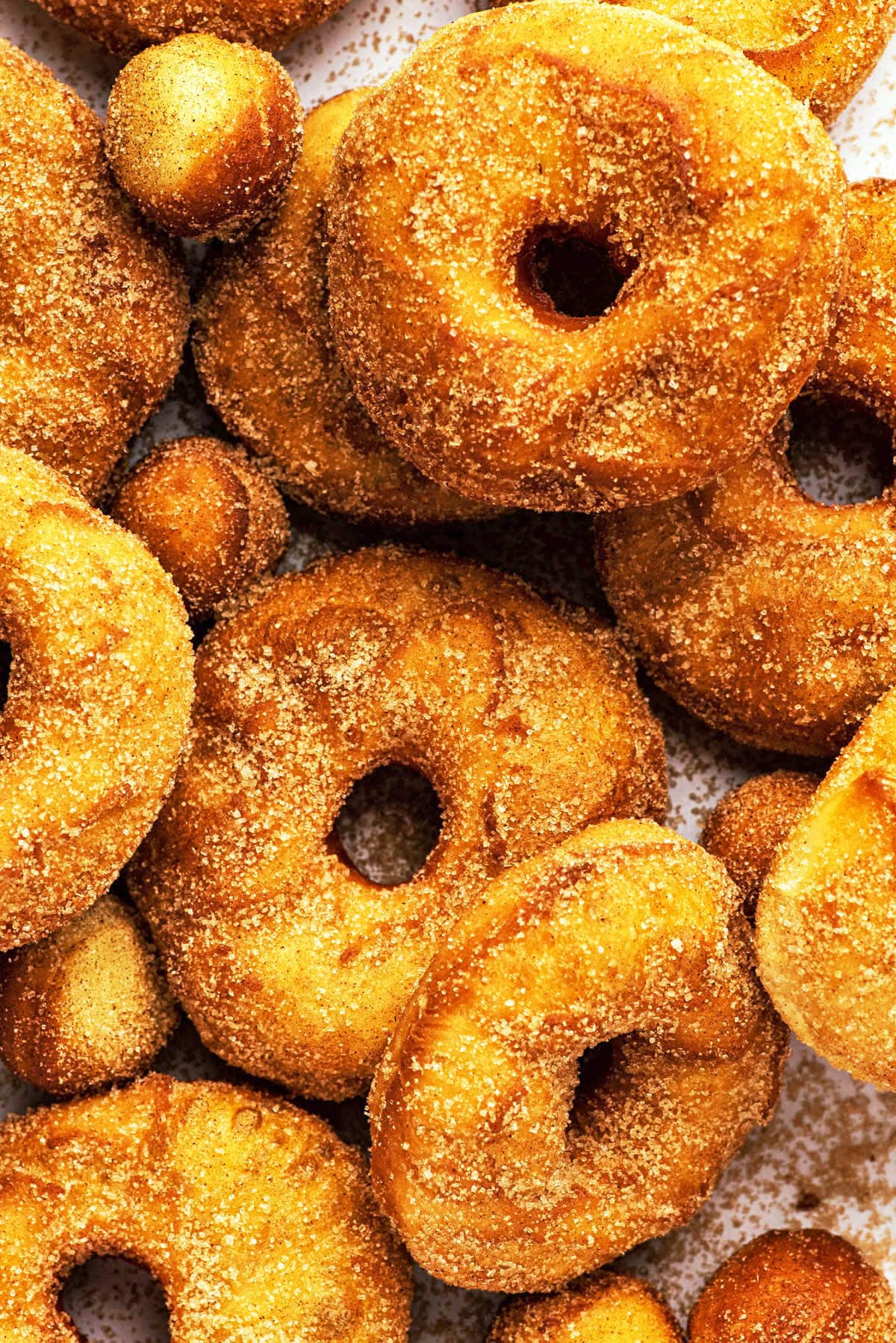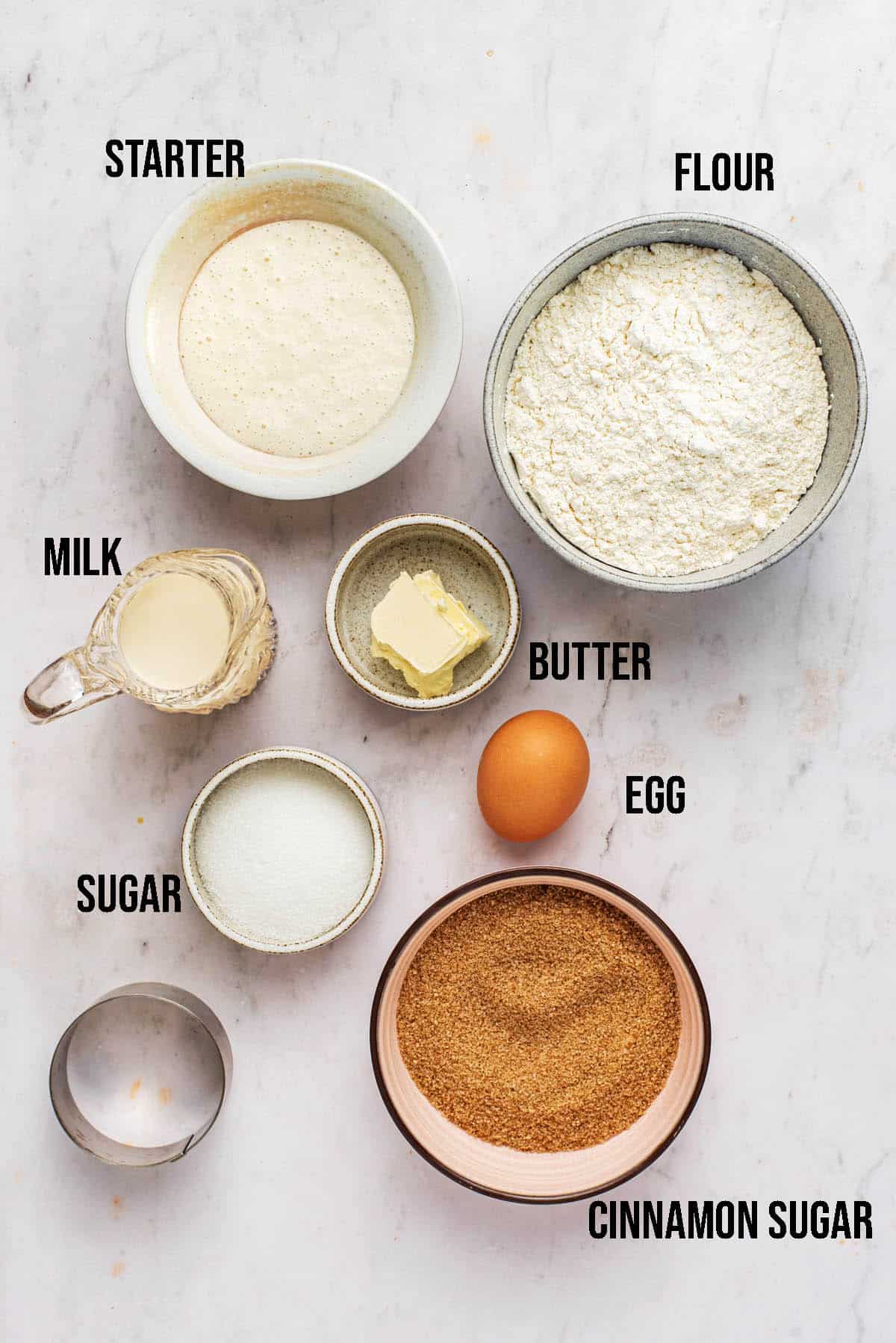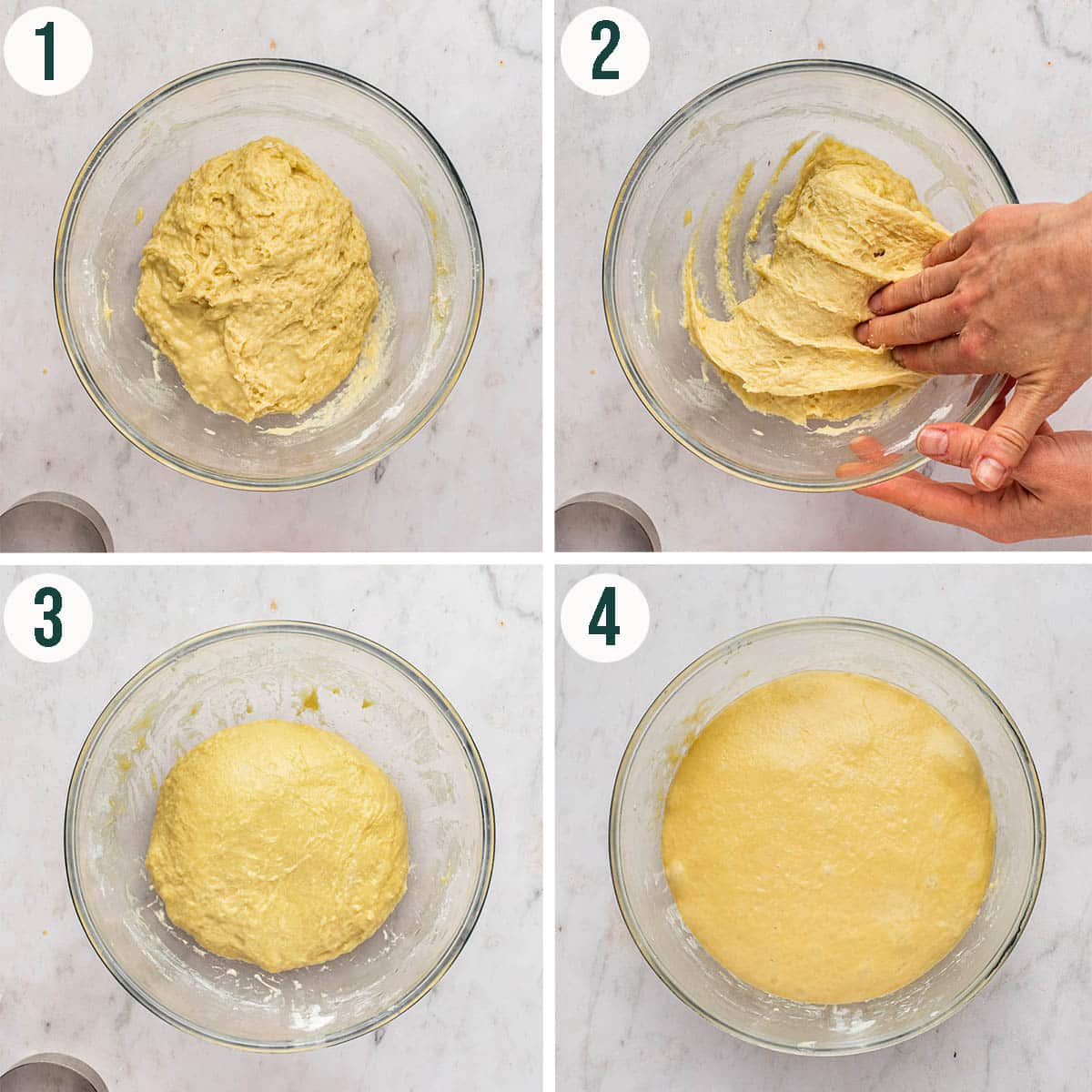Surprisingly simple, made with a buttery enriched dough, sourdough donuts can be made at home! These naturally leavened treats don't use any added yeast and are no-knead. They're surprisingly easy to make, especially if you're familiar with deep frying. If you can make sourdough cinnamon rolls, you can definitely make donuts.
The texture of these donuts is sublime, and you don't need a special stiff starter. Just use a fed and active sourdough starter (discard doesn't work, as there's no additional yeast in the recipe). If you prefer a glaze rather than cinnamon sugar, try topping these with a maple glaze.

Jump to:
Ingredients

Ingredient Notes and Substitutions
- Add a filling: for jam donuts, skip the hole-cutting step and fry them as larger donuts. Fill with strawberry jam or your favourite jam or jelly.
- Flour: this recipe used plain white flour, not strong bread flour. This is because we want a softer, cake-like crumb, but still with enough strength for bread making. Bread flour will make for chewy donuts and cake flour will make them too crumbly.
- Make it dairy-free: use a good vegan butter and dairy-free milk.
- Oil: use an oil that's meant for frying. Sunflower and (organic) canola are our top choices.
Method

Step 1: warm the milk, then mix with the butter and sugar. Add the starter and egg, then mix in the dry ingredients.
Step 2: do three rounds of stretches and folds.
Step 3: set the dough aside to rise.
Step 4: once the dough has doubled in size, it's ready to shape.

Step 5: shape the dough as you would for a boule, then roll out and cut the donut shapes.
Step 6: let the donuts rise until slightly puffy, then fry in a deep-fryer or deep pot.
Step 7: drain the donuts on a plate with paper towel or a clean tea towel.
Step 8: coat the donuts in cinnamon sugar and serve.
Top Tips
- Make sure it's at room temperature: if your eggs or any of the other ingredients are cold, it will cause the dough to rise very slowly. Make sure everything is at room temperature to avoid any delays.
- Use a thermometer: the ideal frying temperature for donuts is 375°F, or 190°C. Use a thermometer to ensure accuracy, it's important. A lower temperature will result in greasy donuts, and a higher one will make them burn.
- Chill the dough: any enriched dough will be easier to shape and cut when cold, as it's so soft when warm. Chill it before shaping to make things easier on yourself.
- Coat while warm: dip the donuts in the cinnamon sugar while they're still warm for most even coverage. If adding a glaze or filling, cool the donuts first.
Recipe Notes
As with any deep-fried treat, it's good to be cautious and make sure you know what you're doing in advance. Here's a helpful guide.
If you're unfamiliar with shaping, see our post on how to shape sourdough boules. This is the same method, just with the additional steps of rolling and cutting the dough. Also see this post on stretching and folding sourdough.
Some people use pieces of parchment paper under donuts or other deep-fried dough, and then drop the whole thing in the oil. If that's the way you do it, then go for it, but we think it's fiddly and unnecessary.
The dough can be refrigerated overnight before shaping and frying, but this adds an additional layer of sour flavour, which isn't really desirable in donuts. It will also rise very slowly when brought out at room temperature again due to the high fat content in the dough.
For the donut holes, constant stirring while they're frying will make for evenly cooked donuts. They can't be flipped like larger donuts and take less than a minute to cook.
We haven't tried making these in an air-fryer, but it's on the to-do list. We'll update when we do.
How to Store Sourdough Donuts
Storage: the donuts are best the day they're made, but will keep for a couple days in a sealed container. If it's humid the sugar might melt a bit.
Freezing: freeze donuts, without any coating or glaze, in an airtight container for up to a month. They will be slightly dry when thawed but still taste good.
FAQ
What is the difference between sourdough donuts and regular donuts?
Sourdough donuts are made with wild yeast, a sourdough starter, instead of commercial yeast or baking powder. They have a stronger flavour and a little more texture than regular donuts.
What are sourdough donuts made of?
Sourdough donuts are made with a sourdough starter, and typical donut ingredients like flour, sugar, butter, eggs, and milk.
What is the difference between brioche and bomboloni donuts?
There is no difference apart from the name. The same donut across Europe is made with an enriched dough - brioche dough - but called bomboloni in Italy and Berliner or Krapfen in Germany.
If you make this Sourdough Donut recipe or any other sourdough recipes on the Baked Collective, please take a moment to rate the recipe and leave a comment below. It’s such a help to others who want to try the recipe. For more baking, follow along on Instagram, TikTok, and YouTube.
Sourdough Donuts
Equipment
- Small saucepan
- Mixing bowl
- Whisk
- Wooden spoon or spatula
- Digital kitchen scale
- Round biscuit cutter (7cm / 2 ¾ in. diameter)
- Piping tip
- baking sheet
- Parchment paper
- Paper towel
Ingredients
- 90 grams whole milk
- 30 grams butter
- 50 grams sugar
- 100 grams active starter
- 1 large egg at room temperature
- 230 grams white all-purpose flour
- 3 grams sea salt a pinch
- Oil for deep frying
- Cinnamon sugar for coating
Instructions
- Heat the milk in a small saucepan until just simmering. Alternatively, microwave until hot.
- Add the hot milk to a large mixing bowl. Add the butter and sugar. Once the butter has melted, whisk to combine.
- The milk mixture should be warm, but not hot, to the touch. Whisk in the active starter.
- Add the egg and whisk to combine.
- Add the flour and salt to the bowl and use a wooden spoon or spatula to mix until a shaggy dough forms.
- Cover and set the dough aside. Every twenty minutes over the course of the next hour, do a round of stretches and folds. After this time, the dough should be soft and form a ball easily.
- Cover and set the dough in a warm or room-temperature place to rise until doubled in size. The time needed will depend on ambient temperature and the strength of your starter, but it should need anywhere from 4-8 hours.
- Once the dough has risen fully, chill for at least 2 hours. This is optional but will make it much easier to shape.
- Shape the chilled dough. Turn it out onto a lightly floured surface, flatten slightly, then roll into a spiral log shape. Turn the log so that the short end faces you, seam-side up, and roll it into a spiral again.
- Flip the dough seam-side down and tuck the edges under it. Rotate the dough with your hands to make a ball with some tension on the outside of the dough, the same as you would for a sourdough boule.
- Roll the dough out to 1.5cm (⅔ in.). Use a round biscuit cutter (7cm / 2 ¾ in. diameter) to cut rounds in the dough. Use the large end of a piping tip to cut holes in the centre of each round.
- Carefully lift the cut donuts and place them onto a parchment paper lined baking sheet. Repeat rolling and cutting the dough until it's all been used.
- Cover the donuts with a damp tea towel and set aside to rise again until puffy looking, 1-2 hours.
- Once the donuts have risen, heat the oil for deep frying. It should be 375°F (190°C). Line a large plate with paper towels and prepare the cinnamon sugar.
- Fry the doughnuts for just over 1 minute each side. Flip when you see the bottom half has browned, but if the oil is the correct temperature, it should take 2 minutes per donut. Carefully remove from the oil with a slotted spoon and set on the paper-lined plate to dry.
- While the donuts are still warm, coat them in cinnamon sugar. Repeat with step 16 until all of the donuts are fried.
- For the donut holes, fry for just under 1 minute, stirring constantly to ensure even browning. Dry on the plate before rolling in cinnamon sugar.
- Sourdough donuts are best eaten fresh, but will keep for a day or two in a sealed container at room temperature.




